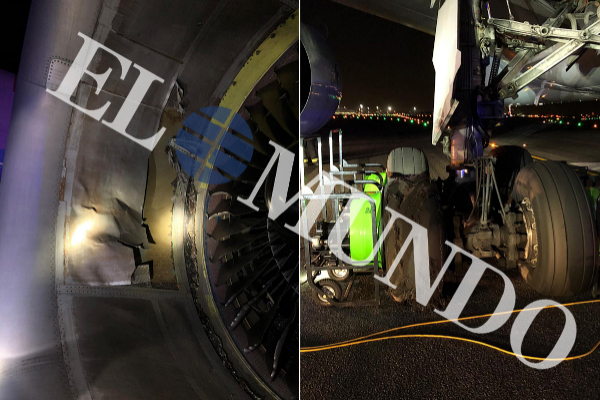- The incident: An Air Canada plane landed emergency in Barajas
- The pilot. The message to the passage: "We have to get rid of fuel"
- The professionals.Sepla considers "good" that the Air Canada plane carries a lot in the air because it is not a "vital emergency"
The tread of one of the rear wheels of the left leg of the landing gear of the Air Canada B-767 that landed emergency, on Monday afternoon, at the Madrid-Barajas Adolfo Suarez airport, detached in the take-off maneuver, forcing the aircraft to abort the flight and return. The device also suffered damage to the left engine, damaging the blades, that is, the vanes that control the flow of air entering the turbine of the plane.
Here are the facts that forced the commander of flight ACA-837 to return to the airport when he was about to embark on a route of more than seven hours and more than 6,000 kilometers bound for Toronto ( Canada ). At the expense of carefully inspecting the damaged wheel, aeronautical experts familiar with the facts informed this newspaper that the wheel lining could have come off due to tire fatigue or broken bolts (screws) that join the pieces.
Another reason that is shuffled is that there was garbage on the runway, that is, an obstacle that hit the wheel while the plane rolled at 250 kilometers per hour before getting up and sailing . The undercarriage of the B-767 is composed of eight wheels - four on each leg -, in addition to the two front ones located under the nose of the plane. Each of the wheels is coated - retreaded, in aeronautical slang - with treads.
One of the first hypothesis that is shuffled is that part of the rubber of the wheel that was dismissed hit the engine. However, the sources consulted warn that it is an unknown how it happened, since the turbine is more advanced than the damaged wheel and it is necessary to examine in detail the damage suffered by the engine.
The four situations that occur when rubber is released from the wheel of an airplane in full take-off maneuver are the following. First, the rubber stays on the floor of the track. Second, when detached you can hit the bottom of the fuselage of the aircraft, which is the closest to the landing gear. Third, it breaks back and damages the tail rudder of the plane. And fourth, there are cases in which you can detach forward for indeterminate reasons.
The rugged B-767, registration C-GHOZ , is 30 years old. He made his first flight on March 31, 1989 with the Canadian Airlines company. In 1997 he changed owners and started operating with the Varig airline, with which he spent eight years. In October 2005, this Boeing began to be operated by Air Canada .
The aircraft took off from Barajas airport at 2:57 p.m. on Monday and landed at 7:06 p.m., according to data provided by Flightradar24 on air traffic in real time. The plane spent four hours flying over the sky of Madrid and its surroundings, without moving more than 75 kilometers away from the airport. The commander used that period of time to get rid of fuel and lighten the weight of the plane for a better landing.
According to the criteria of The Trust Project
Know more- Boeing
- Baraja's airport
- Air accidents
IranUkraine includes the demolition by a missile among the possible causes of the plane crash in Iran
Middle East Iran shot down the Ukrainian plane by mistake, according to the Intelligence of the US, Canada and the United Kingdom
Aviation The accident of 737-800 in Tehran gives the lace to Boeing that already suffers the worst crisis in its history

